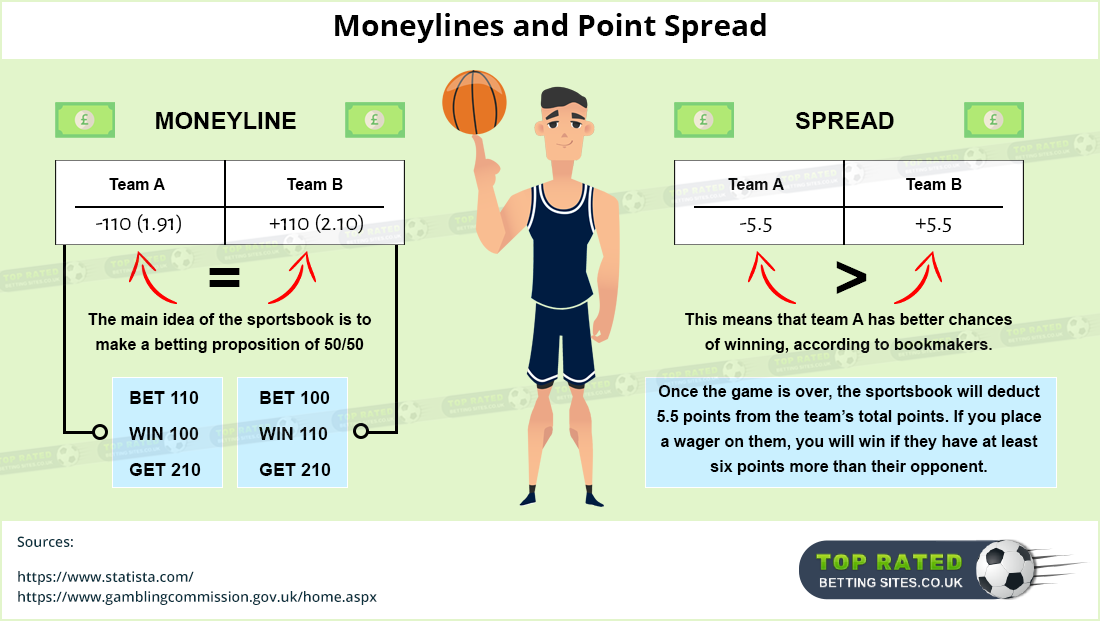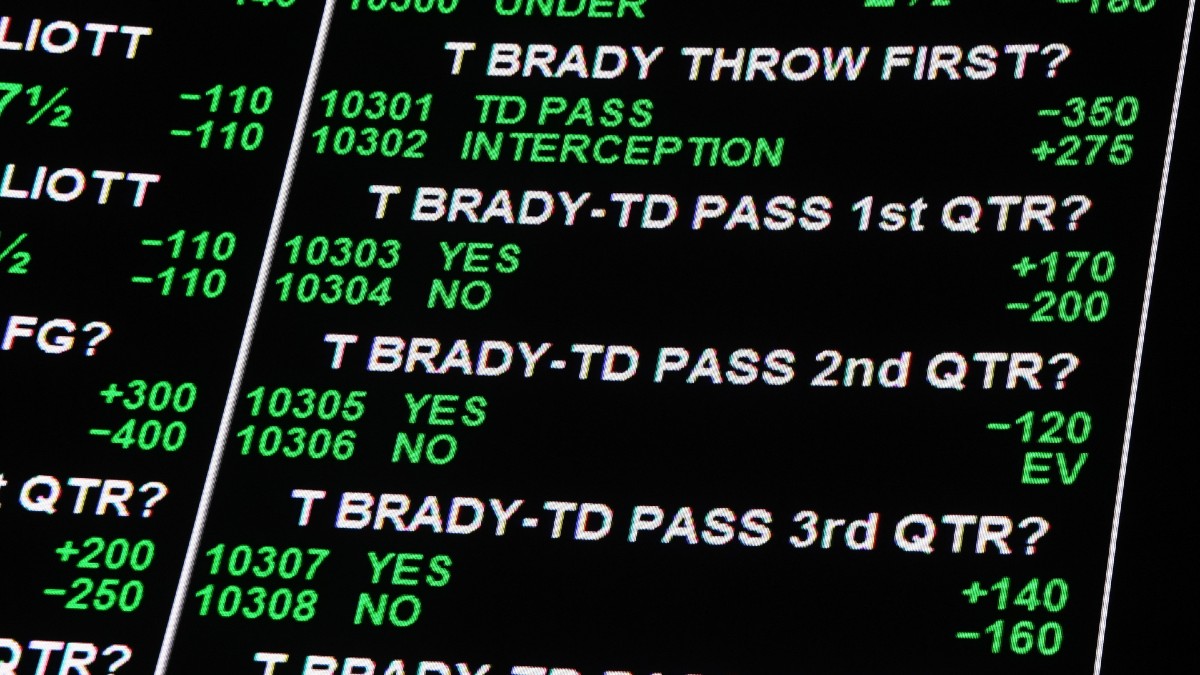Point Spreads Explained The point spread is probably the most common bet when you think of wagering on a single sporting event. That is because it's designed to bring the two teams to an even playing field through the use of a handicap installed by oddsmakers. OVER/UNDER Explained. A sports betting OVER/UNDER is a bet where you have to correctly predict the combined score of both teams. You have to pick if the total score will be lower or higher than the number set by oddsmakers – the people at betting sites who set the lines and odds.
Easily the most popular type of betting for NFL football is “spread” betting or more commonly known as betting against the spread. Bettors who are new to NFL betting or betting in general may be a little confused with NFL spread betting, but it is pretty easy to understand once it is explained to you. We will explain what betting against the spread means below.
What is Betting Against The Spread?
For each NFL game the oddsmakers set a number of points in which the favored team is favored by. Bettors can then either choose for the favored team to win by more than the number of points set, or bet on the underdogs to lose by less than the number of points they are underdogs by or win the game straight up. For example, the spread could be set on the favored team at 6.5 points. This would mean in order for a bet on the favored team on the spread to win they would need to win by more than 6.5 points (7 or more) in order to win the bet. It also means that a bet on the underdog team would win if the underdogs lost by less than 6.5 points (6 or less) or won the game outright.
Example of NFL Spread Bet
Below is an example of what NFL spread betting would look like:
Matchup
- TeamsSpread
- Dallas Cowboys -2.5
- New York Giants +2-5
The negative (-) sign indicates that the Cowboys are the favorites, while the positive (+) sign indicates that the New York Giants are the underdogs. With the spread set at 2.5 points, a bet on the Cowboys would mean that they would have to win by more than 2.5 points (3 or more) in order for you to win that bet. A bet on New York would mean that the Giants would have to either lose by 2.5 or less points (2 or less) or win the game outright in order for your bet to win.
Here is another example with a screenshot taken from 5Dimes.eu during Week 3 of the 2013 NFL season:
Here you can see that the Rams are +3.5, while the Cowboys are -3.5. So for this example the Cowboys are 3.5 point favorites, while the Rams are underdogs of 3.5 points. If you were to bet on St Louis you would need them to lose by 3 or fewer points or just win the game outright. If you were to bet on Dallas you would need the Cowboys to win by 4 or more points.
If the Cowboys were to win by 3 points, lets say 30-27, any bets on the Rams +3.5 would win. Even though the Rams didn’t win the game they covered the spread of 3.5 points.
Now if the Cowboys were to win by 4 points, lets say 31-27, the Cowboys have covered the spread and anyone who wagered on Dallas would win their bets.
Other NFL Spread Betting Information
You may often notice that the spread is sometimes set at an even number such as 3, 6 , 10, etc. In this case if the favored team won by the exact amount set for the spread the bet would be pushed, and all bets would be returned. For example, if the Patriots were 3 point favorites and they won by a FG (3 points) than this would results in a push, meaning no matter which side you bet on you would get your money returned to you.
The most common NFL spreads are usually set between about 2.5-10.5 points, but you will also almost always have games each week with spreads lower than 2.5 and higher than 10.5. In the event that the oddsmakers feel the game doesn’t need a spread, it would be set at 0 or what some call a pick’em (both teams are given even odds to win for this type of bet).
The odds given on the spread are usually -110 unless otherwise noted. It is not uncommon to see one side of the spread being -105, with the other side being -115. If you don’t see any odds listed for each side of NFL spreads you are supposed to assume the odds are -110 on each. Not sure how to read NFL betting odds? Check out our Sports Betting Odds guide.
Now that you know the basics of NFL spread betting you’ll want to check out our Sports Betting Strategy guide which has some great NFL strategy articles written by a professional bettor.
Ever want to bet on an event and find yourself questioning what it means to bet the point spread? Here’s what you need to know about point spread betting.


The large majority of wagers involve bettors are picking a side in a game between two teams or individuals. Not all sides are created equal, though. A point spread is used by oddsmakers to even out a matchup from a betting perspective, assigning more or fewer points to a team’s final score. In order to win a point spread wager, a bettor must “beat the spread.” As a result of a more even matchup, point spread betting offers flatter payouts that are often even on both sides.
- Use Promo Code: SHARPSIDE
- Available In 31 States!
- Fun, Fast Prop Picks
What is a point spread?
This is one of the most common questions in sports betting, especially to new sports bettors. The point spread is how teams or sides of varying skill levels are handicapped against one another. It’s the number of points one side is giving or receiving as compared to the other.
Although each team may roster the same number of players, play by the same rules, or even run some of the same plays, the two sides are almost never equal in skill. To account for that inequality between the two teams, a point spread is used to handicap the two sides of a matchup.
If you look at the odds board and see a team’s or individual’s name followed by a minus sign and a number, that reflects that side is favored by that number of points. In the case that you see a plus sign and a number, that side is the underdog in the matchup. The minus sign means that the final score will have the spread number subtracted from it. The plus sign means that the team’s final score will have the spread number added to it.
In summary, the point spread is a calculated prediction of how much a team will win or lose by.
Why do sportsbooks use point spreads?
As we said before, not all teams are created equal. Sportsbooks use point spreads to handicap a matchup in an attempt to attract equal betting on both sides and even out the competition. Without a point spread, it would be too easy for bettors to simply take the favorite in every matchup. That’s similar as to why you see moneyline betting odds priced accordingly.
In a perfect world, sportsbooks and oddsmakers would draw perfectly balanced 50-50 betting action on both sides of a point spread. This alleviates a sportsbook’s or oddsmaker’s need for one side to win. The large majority of point spread bets come with a juice applied to the payout odds. The juice is another term for the “vig” or “rake,” and it is the money a sportsbook or sports betting operator takes on a wager.
Perfectly balanced betting on both sides would allow sportsbooks and oddsmakers to collect the juice free of liability.
How to know if a point spread bet won or lost?
In order for a point spread bet to be declared a winner, the side wagered on must “cover” the point spread. The favorite, which is the side with the minus number as the point spread, must win by more than the point spread dictates. The underdog, which is the plus number as the point spread, cannot lose by more than the point spread dictates.
Are ties allowed?
Yes, ties can happen when point spread betting. If the point spread is an even number and the difference in the competition’s result falls directly on that number such that the teams are then evenly scored, it is a tie. In point spread betting, a tie is called a “push.”
In the case of a push, all bets are returned to the bettor. If you wagered $100, you would receive your $100 back.
In many cases, point spreads will not be an even number. Rather, point spreads will display a half of a number, .5, and that is called the “hook.” When there is a hook involved, the bet cannot be a push because there are no half points in sports scoring. More information regarding the hook can be found below, in the section about key numbers.
Example of point spread betting
Point spreads are most commonly used and referred to in football betting. Using an example, let’s say the Buffalo Bills are facing off against the New England Patriots and that the game is in New England. When reviewing the oddsboard with the list of games, you see a number of -8 next to the Patriots team name and a number of +8 next to the Bills team name. This means that New England is favored by 8 points and that Buffalo is the underdog by 8 points.
What you’re seeing might be displayed something like the following:
- Buffalo Bills +8 (-110)
- New England Patriots -8 (-110)
Using another example of the Pittsburgh Steelers as -3 favorites over the Dallas Cowboys, let’s say the game results in a score of Pittsburgh 20 and Dallas 17. This final score would result in a push, as it fell on the exact 3-point spread that was being applied.
Do note that when it comes to point spreads, the underdog number isn’t always shown. Rather, a sportsbook will most likely only display the favorite’s spread and it’s assumed the underdog’s spread is simply the opposite.

Whatever the final score of the game turns out to be, New England will have 8 points subtracted from its total if that’s the side you bet on. If you bet on Buffalo’s side, the final score for the Bills will have 8 points added. If the final score results as 30-20 in favor of New England, bettors holding a Patriots -8 ticket would win the bet because the Patriots won by 10. Bettors who wagered on the Bills +8 would lose because the Bills lost by 10.
How much can I win on a point spread wager?
It’s most common in point spread betting to have odds of -110 on both sides. This means that if you bet $110, you’d win $100. There is where the juice comes into play. If sportsbooks were able to attract perfectly even betting action on both sides, they’d be keeping $10 of every $110 wager placed.
Sometimes, you may see a point spread bet listed with odds of -105, -115, or even -120. In those cases, you would need to bet $105, $115, or $120, respectively, to win $100. Then there are also times in point spread betting when a wager has even odds, listed as Even or +100, so whatever you bet you’ll get back.
Because oddsmakers will adjust point spreads as they see fit, another way to alter the handicap is by changing the odds slightly.
- Use Promo Code: SHARPSIDE
- Available In 31 States!
- Fun, Fast Prop Picks
Wait, point spreads can change?
Yes. Sportsbooks and oddsmakers may very well change a point spread to keep the handicap even. Injuries, starting lineups, weather, and volume of bets on one side or the other are a handful of the reasons for a point spread to change. Don’t let the thought of a changing point spread scare you, because these changes can work to your advantage. Of course, they can also work to your disadvantage.
Sticking with the previous example, here’s how the betting line for the Bills and Patriots looked to start.
- Buffalo Bills +8 (-110)
- New England Patriots -8 (-110)
That’s where the line opened, but then later in the week, much closer to game time, the line changed to the following.
- Buffalo Bills +7 (-110)
- New England Patriots -7 (-110)
This shift signifies that New England moved to become less of a favorite than at the opening line. If you’re a bettor who placed a wager on the Bills at +8, this is good news for you, as you’re now getting an extra point that isn’t available anymore. If you placed a wager on the Patriots -8, you now need to overcome an additional point to win.
Many sharp bettors make a practice of watching and predicting line movements. This is done in an attempt to get the best number possible.
Just as points spreads move, they aren’t uniform from venue to venue, so be sure to shop around at various sportsbooks to get the best line that you can.
Understanding key numbers
When it comes to a point spread, it’s important to understand the key numbers. This is especially true for bettors wagering on football, because football point spreads are where the key numbers tend to have the most significance.
Due to how the scoring is structured in football, with field goals being worth 3 points and touchdowns being worth 7 points when you include the 1-point extra point, the most common margins of victory are 3 and 7 points. Knowing and understanding the importance of these key numbers can allow a bettor to make better wagers.
In point spread betting, you’ll often hear bettors reference the “hook.” The hook is the extra half point attached to the spread, very commonly seen in football betting. When betting on a favorite and understanding the importance of key numbers and the hook, it’s beneficial for a bettor to lay fewer than 7 points or fewer than 3 points. Similarly, it’s better to lay 7 points with a favorite than have to cover 7.5 points. The same can be said for 3.5, 3, and 2.5 – having to lay 3 points is much better than having to lay 3.5, and having to lay 2.5 is far greater than having to lay 3.
This also works for the other side of a point spread, the underdog. Any time a bettor can, he or she will want the benefit of having the hook in his or her favor. It’s much better to have an underdog if you’re getting 3 points than just 2.5, or 3.5 points instead of 3. Understanding the importance of key numbers and the hook can be the differences between winning a bet or not.
Although more attention is given to key numbers in football, they are worth paying attention to in basketball, too. Key numbers in basketball come into play less often than in football, but they’re still worth knowing what they are. In basketball, the most common margins of victory are between 5 points and 8 points, followed by 3 points and 4 points.
Gambling Point Spread Explained Definition
Puck line and run line
Point spreads are used mainly in football and basketball. In hockey, the point spread is referred to as the “puck line.” In baseball, a point spread is called the “run line.” In hockey and baseball, the puck line or run line are commonly -1.5 or +1.5 and the lines themselves don’t change but the odds might.
Gambling Point Spread Explained Spread
For more definitions of common sports betting terms, check out SharpSide’s dedicated glossary page.